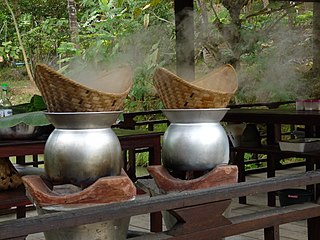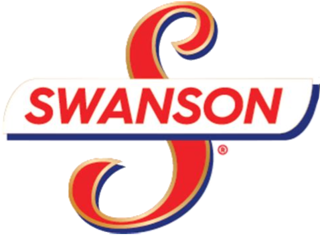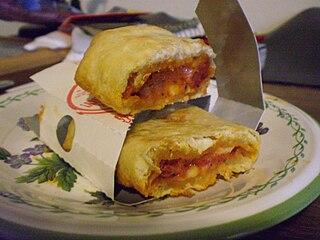Related Research Articles

Grilling is a form of cooking that involves dry heat applied to the surface of food, commonly from above, below or from the side. Grilling usually involves a significant amount of direct, radiant heat, and tends to be used for cooking meat and vegetables quickly. Food to be grilled is cooked on a grill, using a cast iron/frying pan, or a grill pan.

Steaming is a method of cooking using steam. This is often done with a food steamer, a kitchen appliance made specifically to cook food with steam, but food can also be steamed in a wok. In the American southwest, steam pits used for cooking have been found dating back about 5,000 years. Steaming is considered a healthy cooking technique that can be used for many kinds of foods.

A microwave oven is an electric oven that heats and cooks food by exposing it to electromagnetic radiation in the microwave frequency range. This induces polar molecules in the food to rotate and produce thermal energy in a process known as dielectric heating. Microwave ovens heat foods quickly and efficiently because excitation is fairly uniform in the outer 25–38 mm(1–1.5 inches) of a homogeneous, high water content food item.

Freezing food preserves it from the time it is prepared to the time it is eaten. Since early times, farmers, fishermen, and trappers have preserved grains and produce in unheated buildings during the winter season. Freezing food slows decomposition by turning residual moisture into ice, inhibiting the growth of most bacterial species. In the food commodity industry, there are two processes: mechanical and cryogenic. The freezing kinetics is important to preserve the food quality and texture. Quicker freezing generates smaller ice crystals and maintains cellular structure. Cryogenic freezing is the quickest freezing technology available due to the ultra low liquid nitrogen temperature −196 °C (−320 °F).

A frozen meal, prepackaged meal, ready-made meal, ready meal (UK), frozen dinner, and microwave meal) is a packaged frozen meal that comes portioned for an individual. A frozen meal in the United States and Canada usually consists of a type of meat for the main course, and sometimes vegetables, potatoes, and/or a dessert. The main dish can also be pasta or fish. In European frozen meals, Indian and Chinese meals are common. Another form of convenience food, which is merely a refrigerated ready meal that requires less heating but expires sooner, is popular in the UK.

An oven is a tool which is used to expose materials to a hot environment. Ovens contain a hollow chamber and provide a means of heating the chamber in a controlled way. In use since antiquity, they have been used to accomplish a wide variety of tasks requiring controlled heating. Because they are used for a variety of purposes, there are many different types of ovens. These types differ depending on their intended purpose and based upon how they generate heat.

A convection oven is an oven that has fans to circulate air around food which gives a very even heat. The increased air circulation causes a fan-assisted oven to cook food faster than a conventional non-fan oven, which relies only on natural convection to circulate the hot air. Fan-assisted convection ovens are also used for non-food, industrial applications. Fan-assisted convection ovens are commonly used for baking.

A baked potato, known in some parts of the United Kingdom as a jacket potato, is a preparation of potato. The ideal baked potato has a fluffy interior and a crispy skin. It may be served with fillings, toppings or condiments such as butter, cheese, sour cream, gravy, baked beans, and even ground meat or corned beef.

Induction cooking is performed using direct induction heating of cooking vessels, rather than relying on indirect radiation, convection, or thermal conduction. Induction cooking allows high power and very rapid increases in temperature to be achieved, and changes in heat settings are instantaneous.

Swanson is a brand of TV dinners, broths, and canned poultry made for the North American and Hong Kong markets. The former "Swanson Company" was founded in Omaha, Nebraska, where it developed improvements of the frozen dinner. The TV dinner business is currently owned by Conagra Brands, while the broth business is currently owned by the Campbell Soup Company. TV dinner products currently sold under the brand include Swanson's Classics TV dinners and pot pies, and the current broth lineup includes chicken broth and beef broth.

The following outline is provided as an overview of and topical guide to food preparation:

Chicken is the most common type of poultry in the world. Owing to the relative ease and low cost of raising chickens—in comparison to mammals such as cattle or hogs—chicken meat and chicken eggs have become prevalent in numerous cuisines.

A susceptor is a material used for its ability to absorb electromagnetic energy and convert it to heat. The electromagnetic energy is typically radiofrequency or microwave radiation used in industrial heating processes, and also in microwave cooking. The name is derived from susceptance, an electrical property of materials that measures their tendency to convert electromagnetic energy to heat.
The Trivection oven is a convection microwave created by General Electric, which combines radiant heat, convection, and microwaves for customized cooking. According to GE, it cooks food five times faster than a traditional oven. Alton Brown, host of Good Eats, was involved in developing the oven.
Parbaking is a cooking technique in which a bread or dough product is partially baked and then rapidly frozen for storage. The raw dough is baked normally, but halted at about 80% of the normal cooking time, when it is rapidly cooled and frozen. The partial cooking kills the yeast in the bread mixture, and sets the internal structure of the proteins and starches, so that the inside is sterile and stable, but the loaf has not generated "crust" or other externally desirable qualities that are difficult to preserve once fully cooked.

Pasteurized eggs are eggs that have been pasteurized in order to reduce the risk of food-borne illness in dishes that are not cooked or are only lightly cooked. They may be sold as liquid egg products or pasteurized in the shell.

Combi steamers are cooking appliances typically used in professional catering or food service operations. Combi steamers can produce both dry (convection) and moist (steam) heat, and are capable of shifting between them automatically during the cooking process. It can be used to simultaneously steam vegetables or potatoes quickly and gently, while also roasting or braising meat and fish, or baking bread. The appliance is fit for many culinary applications, including baking, roasting, grilling, steaming, braising, blanching and poaching. Combi steamers expand upon standard convection ovens in that they also generate steam or a combination of steam and superheated steam. They help gastronomy-industry professionals bridge the gap between economy and menu diversity while also maintaining the desired food quality.

The kitchen work triangle is a concept used to determine efficient kitchen layouts that are both aesthetically pleasing and functional. The primary tasks in a home kitchen are carried out between the cook top, the sink and the refrigerator. These three points and the imaginary lines between them, make up what kitchen experts call the work triangle. The idea is that when these three elements are close to one other, the kitchen will be easy and efficient to use, cutting down on wasted steps.
An oven bag, cooking bag or roasting bag is a bag used for the roasting of meat or other food in an oven. They may be made of heatproof nylon or sometimes with food grade polyethylene terephthalate (PET). A bag helps to keep the food being cooked moist by trapping the moisture in the bag and preventing it from escaping into the oven; as such, it serves a similar purpose to basting.

Velveeta Shells & Cheese is a shell pasta and cheese sauce food product that debuted in the United States in 1984, as part of the Velveeta brand products. Its ingredients, texture, and flavor are very similar to macaroni and cheese. The product is a shelf-stable food.
References
- ↑ Archived October 28, 2007, at the Wayback Machine
- ↑ "TrueCookPlus: FAQs". Archived from the original on 2016-03-03. Retrieved 2009-07-21.
- ↑ Consumer Reports: Microwave Ovens